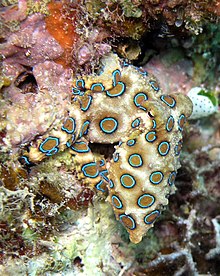Greater blue-ringed octopus: Difference between revisions
m ISBNs (Build KE) |
|||
| Line 46: | Line 46: | ||
[[tr:Büyük mavi halkalı ahtapot]] |
[[tr:Büyük mavi halkalı ahtapot]] |
||
[[zh-yue:藍圈八爪魚]] |
[[zh-yue:藍圈八爪魚]] |
||
jr was here |
|||
Revision as of 16:18, 9 May 2012
| Greater Blue-ringed Octopus | |
|---|---|

| |
| Hapalochlaena lunulata | |
| Scientific classification | |
| Kingdom: | |
| Phylum: | |
| Class: | |
| Order: | |
| Family: | |
| Subfamily: | |
| Genus: | |
| Species: | H. lunulata
|
| Binomial name | |
| Hapalochlaena lunulata | |
The Greater Blue-ringed Octopus (Hapalochlaena lunulata) is one of three (or perhaps four) species of venomous blue-ringed octopuses. Unlike its southern brethren, the Blue-lined and Southern Blue-ringed octopuses that are found only in Australian waters, the range of the Greater Blue-ringed Octopus spans the tropical western Pacific Ocean. Greater Blue-ringed Octopuses can weigh between 10 and 100 grams.[citation needed]
Prey
The Greater Blue-ringed Octopus eats mostly crustaceans such as crabs and shrimp. Also, it eats reef fish that stray too close by. It injects them with a powerful neurotoxin that easily paralyzes them, which allows the octopus to devour its prey.
Toxicity
Their venom (a poisonous saliva), which includes a neurotoxin known as tetrodotoxin, is produced by bacteria in the salivary glands. Tetrodotoxin blocks sodium channels, causing motor paralysis and respiratory arrest within minutes of exposure, leading to cardiac arrest due to a lack of oxygen.[1][2]

References
- ^ Robert Steven Hoffman; et al. Goldfrank's Manual of Toxicologic Emergencies. McGraw-Hill Professional. p. 917. ISBN 0-07-144310-X.
{{cite book}}: Explicit use of et al. in:|author=(help) - ^ Hwang DF, Arakawa O, Saito1 T, Noguchi T, Simidu U, Tsukamoto K, Shida Y and Hashimoto K. (1989). Tetrodotoxin-producing bacteria from the blue-ringed octopus Octopus maculosus. Marine Biology 100(3): 327–332.
- ^ Huffard CL, Caldwell RL, DeLoach N, Gentry DW, Humann P, B. MacDonald, B. Moore, R. Ross, T. Uno, S. Wong. 2008. Individually Unique Body Color Patterns in Octopus (Wunderpus photogenicus) Allow for Photoidentification. PLoS ONE 3(11): e3732. doi:10.1371/journal.pone.0003732
External links
- "CephBase: Greater blue-ringed octopus". Archived from the original on 2005-08-17.
- Animal Diversity Web
jr was here
